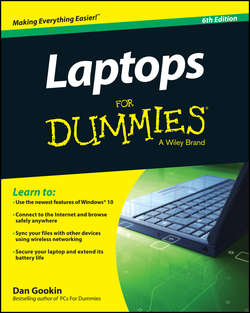Читать книгу Laptops For Dummies - Gookin Dan - Страница 9
На сайте Литреса книга снята с продажи.
Part I
This Laptop Thing
Chapter 2
A Laptop of Your Own
Laptop Shopping
ОглавлениеThe best computer you can buy is the one that does what you need it to do. To find this computer, you have to familiarize yourself with some issues and deliberately ignore others.
Things to ignore when buying a laptop
When it comes to spending your money on a useful computer, especially a laptop, feel free to ignore these items:
Slick marketing campaigns: You’ll never be as cool as the person in the ad, no matter how much effort you put into it. All laptops are tools, and they should be judged by whether they offer features that you need, not by how nifty their advertising looks.
Brand name: Too many people consider brand name first and don’t even know which components they need. Similarly, you don’t need to buy a laptop from the same manufacturer as the one who made your desktop PC. As long as the laptop runs the software you need, you’re fine.
Low price: An abundance of cheap laptops are available. In haste, you may buy a laptop, thinking that you’re getting a deal – but get stuck with a brick instead.
High price: It’s easy to be duped into believing that the most expensive laptop is the best. Buying too much is not a wise buying decision.
Things to heed when buying a laptop
Throughout laptop history, five key items have been vital to the laptop-choosing decision:
Weight: Nearly all laptops weigh between 2 and 7 pounds. The heavier laptops, the notebooks, have more features, such as a larger display or a numeric keypad next to the keyboard. The lighter models, the tablet PCs and subnotebooks, don’t necessarily have fewer features; they might actually have more lightweight or advanced features, which makes them more expensive.
Size: Most laptops are thinner than an inch. Tablet PCs are the thinnest. Subnotebooks are the smallest.
Display: Recently, manufacturers have discovered that people love the larger screen on a laptop – even though the larger display adds to the laptop’s size and weight (and consumes more battery power). For a laptop being used at one location and only rarely going on the road, a huge display is wonderful. If you want portability, though, and a longer battery life, consider a smaller display.
Touchscreen display: If the laptop advertises itself as a tablet PC, or a convertible notebook, it’s going to have a touchscreen display. You can use your finger to manipulate the touchscreen, but also ensure that the laptop comes with a stylus or digital pen, which aids in input.
Battery life: Despite their manufacturers’ claims, most laptops run anywhere from three to five hours unplugged. Subnotebooks and tablet PCs hold the record, with many of them lasting as long as ten hours. Regardless, it’s possible and necessary to manage the laptop’s power; see Chapters 10 and 23.
✔ Stuff that’s important to the overall weight of the laptop – the power brick and cord, keyboard cover, extra batteries, portable storage, and other gizmos – aren’t included in the basic tonnage calculation. Keep these items in mind when weight is important to you.
✔ Convertible laptops are thicker than standard laptops because of the extra circuitry required for their touchscreen displays. See Chapter 7.
✔ If you desire both a large display and portability, consider getting an external monitor for your laptop. That way, you can enjoy the big, roomy screen when the laptop is at your workstation and still have the portability you need when taking the laptop on the road.
